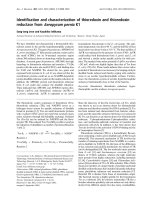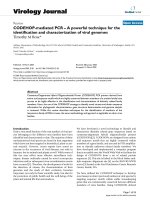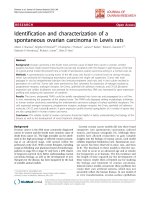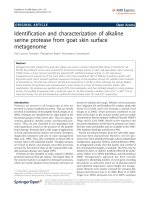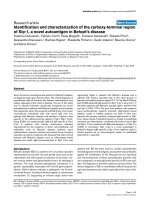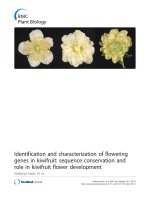Identification and characterization of proteins that interact with zonula occludens proteins
Bạn đang xem bản rút gọn của tài liệu. Xem và tải ngay bản đầy đủ của tài liệu tại đây (6.17 MB, 223 trang )
IDENTIFICATION AND CHARACTERIZATION OF
PROTEINS THAT INTERACT WITH
ZONULA OCCLUDENS PROTEINS
P JAYA KAUSALYA
INSTITUTE OF MOLECULAR AND CELL BIOLOGY
NATIONAL UNIVERSITY OF SINGAPORE
2005
2
IDENTIFICATION AND CHARACTERIZATION OF
PROTEINS THAT INTERACT WITH
ZONULA OCCLUDENS PROTEINS
P JAYA KAUSALYA
(B.Sc. (Hons.), NUS)
A THESIS SUBMITTED FOR THE DEGREE OF
DOCTOR OF PHILOSOPHY
INSTITUTE OF MOLECULAR AND CELL BIOLOGY
NATIONAL UNIVERSITY OF SINGAPORE
2005
3
ACKNOWLEGMENTS
This work would not be possible without the support of family and colleagues. I
wish to thank my parents and brother for their love, understanding and encouragement. I
wish to thank A/P Walter Hunziker for being my mentor and I am grateful for his
guidance and patience. I also, wish to thank my supervisory committee members, Prof
Hong Wan Jin and A/P Cai Ming Jie for their guidance. I thank Dr. Manuela Reichert for
her help during the initial stages of my project and collaborators, Dr. Dominik Muller and
co-workers and Dr. Michael Fromme and co-workers. I am grateful to Dr. K. Willecke
and Dr. Gonzalez-Mariscal for plasmids. I thank past and present members of WH lab
and other IMCB members, in particular Drs. Wong Siew Cheng, Joy Tan, Lu Lei and Yu
Xianwen for useful discussions and support. Last but not least, I thank God for all the
opportunities given to me.
4
TABLE OF CONTENTS
LIST OF FIGURES 7
LIST OF TABLES 9
ABBREVIATIONS 10
MEDICAL DEFINITIONS 13
SUMMARY 14
CHAPTER 1: INTRODUCTION 15
1.1: TIGHT JUNCTIONS 18
1.1.1: Tight junction structure and morphology 18
1.2: Functions of Tight Junctions 20
1.3: Models of Tight Junctions 23
1.4: Protein components of TJ 25
1.4.1: TJ transmembrane proteins 26
1.4.1.1: Occludin 27
1.4.1.1.1: Occludin as a structural and functional component of TJ 27
1.4.1.1.2: Protein-protein interactions of occludin 30
1.4.1.2: Claudins 31
1.4.1.2.1: Claudins as structural and functional components of TJs 34
1.4.1.2.2: Model for claudins in ion- and solute permeability 38
1.4.1.3: Junction Adhesion Molecule (JAM) 39
1.4.2: Peripherally-associated scaffolding proteins 42
1.4.2.1: PDZ domains 43
1.4.2.2: Mechanism of binding and specificity of PDZ domains 44
1.4.2.3: Structure and function of PDZ domain 45
1.4.2.4: Roles of PDZ domains 49
1.4.2.5: SH3 and GUK domains 50
1.4.2.6: The ZO protein family 51
1.4.3: Regulatory proteins 56
1.4.4: Transcriptional and post-transcriptional regulators 57
1.5: Assembly of Tight Junctions 58
1.6: Diseases linked to the TJ function 61
1.6.1: Diseases associated with TJ peripheral proteins 61
1.6.2: Diseases associated with TJ integral membrane proteins 62
1.7: Model systems to study junction assembly and function 65
1.7.1: General techniques 65
1.7.1.1: Epithelial cells as a model cell system 65
1.7.1.2: Permeable supports 66
1.7.1.3: Immunofluorescence analysis for TJ protein localization 68
1.7.2: Analysis of TJ function 69
1.7.2.1: Analysis of fence function 69
1.7.2.2: Analysis of gate function 70
CHAPTER 2: Identification and characterization of proteins that interact with ZO-1
PDZ domains using yeast-two-hybrid 71
Section 2.1: Connexin45 directly binds to the PDZ domains of ZO-1 and localizes
to the tight junction region in epithelial MDCK cells 73
5
2.1: Gap Junction and Connexins 73
Section 2.2: Results 76
Section 2.2.1: The C-terminus of Cx45 interacts with the PDZ domains of ZO-1
and ZO-3 in a yeast two-hybrid assay 76
2.2.2: Characterization of epithelial MDCK cells transfected with Cx45 cDNA. 78
2.2.3: Cx45 directly associates with ZO-1 in vivo 80
2.2.4: Cx45 co-localizes with ZO-1 in the tight junction region in polarized
MDCK cells 81
Section 2.3: Discussion 84
Section 2.4: Association of ARVCF with ZO-1 and ZO-2: binding to PDZ-domain
proteins and cell-cell adhesion regulate plasma membrane and nuclear localization
of ARVCF 89
2.4.1: Cadherins and Catenins 89
2.4.2: The p120 family 93
2.4.2.1: ARVCF 94
2.5: Results 96
2.5.1: ARVCF interacts with ZO-1 and ZO-2 but not ZO-3 96
2.5.2: ARVCF and ZO-1 interact in vivo and partially co-localize in MDCK cells
102
2.5.4: ARVCF can associate with E-cadherin via its armadillo domains or through
binding to PDZ domains proteins 111
2.5.5: Plasma membrane and nuclear localization of ARVCF require the
interaction with PDZ domain proteins and are regulated by cell-cell adhesion . 116
2.5.6: ARVCF, ZO-1 and E-cadherin are recruited to sites of initial cell-cell
contact 118
2.5.7: The PDZ domains of ZO-2 mediate the efficient nuclear localization of
ARVCF 122
Section 2.6: Discussion 126
CHAPTER 3: Characterization of Claudin-16/Paracellin-1 and mutants associated
with familial hypomagnesaemia with hypercalciuria and nephrocalcinosis (FHHNC)
132
Section 3.1: Claudin-16 132
3.1.1: Magnesium Homeostasis and Reabsorption 132
3.1.2: Claudin-16/Paracellin-1 and renal magnesium wasting disorder 133
3.1.3: Magnesium Resorption Mechanism 135
3.1.4: Familial hypomagnesaemia with hypercalciuria and nephrocalcinosis linked
to mutations in CLDN16 gene 137
3.1.5: Objective of study 140
Section 3.2: Results on CLDN16 and mutations 141
3.2.1: Characterization of an antibody to the first extracellular loop of CLDN16
141
3.2.2: Cldn16 internalizes via clathrin-dependent pathway 142
3.2.3: Subcellular and surface expression of Cldn16 mutations 146
3.2.4: Cldn16 mutants that fail reach cell surface localize to the ER and Golgi 148
3.2.5: Characterization of trafficking defects of Cldn16 mutants displaying a
predominant intracellular steady-state localization 151
6
3.2.5: Cldn16 mutants retained in the ER are subject to proteosomal degradation
156
3.2.6: T233R mutation disruption PDZ binding motif and is mistargeted to the
lysosomes 161
3.2.7: Cldn16 mutants delivered to lysosomes use different routes 166
3.3.8: Pharmacological chaperones rescue cell surface expression of several
Cldn16 mutants 168
3.3.9: Cldn16 mutants present in TJ are defective in paracellular Mg
2+
transport
171
3.3.10: Clinical phenotypes 175
Section 3.4: Discussion on Cldn16 and mutations 176
Chapter 4: Concluding Remarks 185
Chapter 5: Materials and Methods 188
5.1 Antibodies and Reagents 188
5.2: Plasmids constructions 189
5.2.1: Cloning of ZO and mutants 189
5.2.2: Cloning of Connexin 45 and mutant constructs 189
5.2.3: Cloning of ARVCF and mutant constructs 189
5.2.4: Cloning of Cld16 and mutants 190
5.3: Yeast Two-Hybrid Screen 190
5.4: Cell Cuture and Transfection of cells 191
5.5: Co-immunoprecipitation assays 192
5.5.1:Cx45 coimmunoprecipitations 192
5.5.2: ARVCF coimmunoprecipitation 192
5.5.3: Cldn16 coimmunoprecipitation 193
5.6: GST Fusion Purification 193
5.7: Pull-down assay 194
5.7.1: ARVCF GST pull down assays 194
5.7.2: Cldn16 pull down assays 194
5.8: Immunofluorescence Labeling 195
5.9: Calcium-switch and cell-cell contact detection protocol 196
5.10: Blot overlay 196
5.11: Cytochalasin D treatment for ARVCF or mutant transfected cells 196
5.12: Endocytosis/ Internalization of CLDN16 and FHHNC mutants 197
5.13: 20˚C block and cyclohexamide experiments 197
5.14: Nocodazole treatment 197
5.15: Pharmacological inhibition of endocytosis 198
5.16: Proteosomal Degradation Western Analysis 198
References 199
7
LIST OF FIGURES
Fig. 1: Junctional complexes.
Fig. 2: Structure of Tight junctions.
Fig. 3: Transcellular and Paracellular pathways.
Fig. 4: Barrier and Fence function of tight junctions.
Fig. 5: Proposed protein and lipid models of TJs.
Fig. 6: The composition of tight junctions.
Fig. 7: Integral membrane proteins of tight junctions.
Fig. 8: Schematic representation of the structure and the membrane topology of claudins.
Fig. 9: Creating a paracellular seal.
Fig.10: Proposed model of ion and size discriminations and flux of charged and non-
charged molecules.
Fig. 11: Interaction of two of the major protein complexes in the TJs.
Fig. 12: The ZO protein family in TJ that are part of MAGUK family.
Fig. 13: Structure of PDZ3 domain of PSD-95 with a peptide ligand.
Fig. 14: Possible modes of interaction of PDZ containing proteins.
Fig. 15: ZO-3 interacts with PATJ, which is part of the Crumbs-Pals-PATJ complex.
Fig.16: Stages of cell-cell contact and polarization.
Fig. 17: Permeable supports use in the study of polarity.
Fig. 18: TJ Barrier analysis.
Fig. 19: Gap junctions between neighboring cells where ions and cAMP molecules are
transferred.
Fig. 20: Gap Junction Structure.
Fig. 21: Characterization of MDCK cells expressing wild type or mutant Cx45.
Fig. 22: Cx45 directly interacts with ZO-1 via the C-terminal SWVI.
Fig. 23: Cx45 co-localizes with ZO-1 to the tight junction region in MDCK cells.
Fig. 24: Main steps involved in connexin synthesis, assembly and turnover.
Fig. 25: Schematic diagram of cadherin molecule showing its functional domains.
Fig. 26: The armadillo family.
Fig. 27: Cadherin-catenin complexes.
Fig. 28: Schematic diagram of the domain structure of ARVCF.
Fig. 29: Schematic diagrams of ARVCF, ZO-1 and ZO-2.
Fig. 30: Binding of ARVCF and ZO-1.
Fig. 31:
A. ARVCF co-precipitates with ZO-1 from transfected MDCK cells.
B. Endogenous ARVCF and ZO-1 coprecipitate from MDCK cells.
Fig. 32: Colocalization of ARVCF and ZO-1 in transfected MDCK cells.
Fig. 33: ARVCF partially colocalizes with ZO-1 to a discrete region between the lateral
plasma membrane and TJ of polarized MDCK cells.
Fig. 34: Colocalization and coprecipitation of ARVCF and ZO-1 or E-cadherin in
transfected MDCK cells treated with cytochalasin D.
Fig. 35: Binding of ARVCF and E-cadherin.
Fig. 36: Plasma membrane recruitment and nuclear localization of ARVCF require the
PDZ-binding motif and are regulated by cell-cell adhesion using calcium switch assay.
8
Fig. 37: I. Recruitment of ARVCF to sites of cell-cell contact in MCF7 cells.
II. Effect of ZO-1 mutants on ARVCF localization in MCF7 cells.
Fig. 38: Role of ZO-2 in nuclear localization of ARVCF.
Fig. 39: Putative E-cadherin/ARVCF/ZO-1 associations and C-terminal PDZ binding
motifs in members of the p120
ctn
protein family.
Fig. 40: Magnesium resorption in nephron segments.
Fig. 41: Sequence, structure and expression of claudin-16.
Fig. 42: A schematic model of magnesium resorption in the cortical ascending limb
(cTAL) of Loop of Henle.
Fig. 43: Predicted topology of CLDN16 and the location of the different mutations
reported in humans.
Fig. 44: Clathrin mediated endocytosis of Cldn16.
Fig. 45: Cell surface expression of Cldn16 mutants linked to FHHNC.
Fig. 46: Steady-state localization of Cldn16 mutants to different subcellular organelles.
Fig. 47: Characterization of intracellular trafficking defects of different Cldn16 mutants.
Fig. 48: Colocalization of Cldn16 mutants with ubiquitin is increased in the presence of a
proteasome inhibitor.
Fig. 49: ER-retained Cldn16 mutants are subject to proteasomal degradation.
Fig. 50: Binding of wild type and mutant CLDN16 to ZO-1.
Fig. 51: Subcellular localization of wild type and mutant CLDN16.
Fig. 52: Cldn16 mutants that localize to lysosomes follow different pathways.
Fig. 53: Chemical chaperones rescue cell surface expression of several Cldn16 mutants.
Fig. 54: TJ localization of Cldn16 mutants expressed on the cell surface.
Fig. 55: Measurements of Mg
2+
permeability (A) and transepithelial resistance (B).
Fig. 56: Predicted topology of Cldn16 and location of the different mutations linked to
FHHNC reported.
Fig. 57: Multiple roles of ZO proteins in the different adhesion junctional complexes.
9
LIST OF TABLES
Table 1: Claudin gene family
Table 2: PDZ domain classes and examples of PDZ ligands.
Table 3: Summary on disease associated with TJ peripheral proteins.
Table 4: Summary on diseases associated with TJ integral membrane proteins.
Table 5: Interaction of the PDZ domains of ZO-1, ZO-2 and ZO-3 with a construct
encoding a C-terminal region of Cx45 or a Cx45 mutant in which the SVWI amino acids
encoding a putative PDZ-binding motif were mutated to alanine.
Table 6: Interaction of the PDZ domains of ZO-1 and ZO-2 with a construct encoding the
C-terminal region of ARVCF (amino acids 670-893) or a mutant thereof (ARVCF∆P) in
which the SWV amino acids encoding a putative PDZ-binding motif were changed to
alanines.
Table 7: Summary of the clinical features of FHHNC.
Table 8: Summary of steady-state localization and defects of Cldn16 mutants linked to
FHHNNC
10
ABBREVIATIONS
Å: Angstrom
AF-6: ALL-1 fusion partner at chromosome 6
AJ: Adherens Junction
ALLN: N-acetyl–leu-leu-norleucinal
Ap: Apical
ARVCF: Armadillo repeat in Velo cardio facial syndrome
Arm: Armadillo
ASIP: atypical PKC isotype specific interacting protein
BBB: Blood brain barrier
Bl: Basolateral
Ca
2+
:
calcium
CAR: Coxsackie and adenovirus receptors
CPE: Clostridum perfringens enterotoxin
Cld or Cldn: Claudin
CLDN16: claudin-16
cTALH: cortical segment of the thick ascending limb of Henle
Cx: Connexin
Dlg: Drosophila Disc-Large
DHR: Disc-large homology regions
EEA1: Early Endosomal marker
EMT: Epithelial-mesenchymal transition
FHHNC: Familial Hypomagnesaemia with hypercalciuria and nephrocalcinosis
11
GAL4 AD: GAL4 DNA activation domain
GLGF: Gly-Leu-Gly-Phe
GST: Glutathione Sepharose Transferase
GFR: Glomerular Filtration Rate
GM130: cid Golgi marker
GUK: Guanylate kinase
HA: Haemagglutinin
HC: Hypercalciuria
huASH: Human absent, small or homeotic disc-1
JAM: Junction Adhesion Molecule
kDa: kiloDalton
MAGUK: Membrane-associated guanylate kinase
MDCK: Madin-Darby Canine Kidney
Mg
2+
: Magnesium
mTAL: medullary segment of the thick ascending limb
MUPP-1: Multi-PDZ domain protein-1
Mv: Microvilli
MW: molecular weight
NC: Nephrocalcinosis
NLS: Nuclear localization signal
Occ: Occludin
Pals1: Protein associated with Lin seven 1
Par-3: Partitioning defective protein-3
12
PSD95: Postsynaptic density protein
PDZ: PSD-95, Dlg, ZO-1
PKC: Protein kinase C
PMP22: Peripheral myelin protein
PVDF: Polyvinylidene difluoride
SDS: Sodium Dodecyl (lauryl) Sulfate
SDS-PAGE: Sodium Dodecyl (lauryl) Sulfate-Polyacrylamide Gel Electrophoresis
SH3: Src homology 3
TER: Transepithelial resistance
TGN: Trans Golgi Network
TJ: Tight Junction
ZO: Zonulae Occludens
ZO-1: Zonula Occludens-1
ZONAB: ZO-1 associated nuclei acid binding
Y2H: Yeast-two hybrid
13
MEDICAL DEFINITIONS
Atrophy: A wasting or decrease in size of a body organ, tissue, or part
owing to disease.
Chorioretinitis: Inflammation of the choroid and retina.
Chondrocalcinosis: The calcification of cartilage.
Hypercalciuria: The excretion of abnormally high concentrations of calcium in the
urine.
Hyperplasia: An abnormal increase in the number of cells in an organ or a tissue
with consequent enlargement.
Hypomagnesaemia: An abnormally low level of magnesium in the blood.
Nephrocalcinosis: Calcium deposits form in the renal parenchyma and result in
reduced kidney function and blood in the urine.
Nephrolithiasis: The presence of kidney stones (calculi) in the kidney.
Nocturnal enuresis: Involuntary discharge of urine, especially when occurring
nocturnally during sleep
Nystagmus: A rapid, involuntary, oscillatory motion of the eyeball.
Tenany: An abnormal condition characterized by periodic painful muscular
spasms and tremors, caused by faulty calcium metabolism and
associated with diminished function of the parathyroid glands.
14
SUMMARY
Zonulae Occludens (ZO) or tight junctions (TJ) are specialized plasma membrane
domains that regulate the paracellular transepithelial permeability and prevent the inter-
mixing of apical and basolateral plasma membrane components. TJs consist of integral
membrane proteins such as claudin, occludin and JAM proteins that are linked via
cytoplasmic peripheral proteins e.g. ZO-1, -2 and -3 to the actin cytoskeleton.
This study identifies the roles of zonula occludens (ZO) proteins and characterizes
their interacting partners. Novel proteins that interact with ZO-1 were identified using a
yeast-two-hybrid screen. A gap junction protein, Connexin 45, and a member of p120
catenin family, Armadillo velo-cardio facial syndrome (ARVCF), were identified and the
functional significances of their interaction were analyzed. In the second part, TJ integral
membrane protein, claudin-16, was shown to interact with ZO-1 and its role in TJ barrier
function was analyzed. Mutations in claudin-16 have been linked to familial
hypomagnesaemia with hypercalciuria and nephrocalcinosis (FHHNC), where affected
individuals excrete excessive magnesium and calcium in the urine, leading to kidney
stones and end-stage renal failure. The molecular mechanisms by which these mutations
affect CLDN16 function were determined by analyzing their effect on intracellular
transport and paracellular Mg
2+
and Ca
2+
transport. Interestingly, mutations associated
with FHHNC could affect either the correct intracellular transport of CLDN16, or its
function in paracellular ion transport. Chemical chaperones restored surface transport of
some of the CLDN16 mutants analyzed, thus providing a possible therapeutic
intervention for FHNNC.
15
CHAPTER 1: INTRODUCTION
Multi-cellular organisms are composed of organs and tissues with
compositionally distinct and specialized fluid compartments that are important for
development and functional maintenance of the organism. Various cellular sheets that
delineate these compartments function as barriers to maintain the distinct internal
environment of each compartment. For example, blood vessels, renal tubules and
peritoneal cavity are lined with endothelial, epithelial and mesothelial cells respectively.
Each cell is mechanically linked with adjacent cells to maintain the integrity of the
cellular sheet and to prevent the unregulated diffusion of molecules through the
intercellular space.
Epithelial cells are polarized cells that have apical and basolateral plasma
membrane domains and they adhere to each other through junctional complexes. These
cells can have different types of intercellular junctions including tight junctions (TJ,
zonal occludentes), adherens junctions (AJ, zonulae adherentes) and desmosomes
(maculae adherentes) (Fig. 1). TJ and AJ make up the so-called junctional complex. TJs
in epithelial cells encircle the apical border of the lateral membrane. They form an
intracellular seal that acts as a barrier and fence to prevent paracellular diffusion and
intermixing of proteins and lipids between the apical and basolateral plasma membrane
domains, respectively. AJs and desmosomes are mechanically linked to AJ and
desmosomes on neighboring cells as well as to the actin and intermediate filament
cytoskeleton, respectively, providing strength and rigidity to the entire tissue. AJs can be
localized to the vicinity of TJs (to form the so-called apical adhesion complex) or be
distributed along the lateral membrane (reviewed by Matter and Balda, 2003 and Tsukita
16
et al., 2001). Gap junctions form intercellular pores that allow the diffusion of small
hydrophilic molecules and ions to pass between cells. Desmosomes and gap junctions can
be found along the lateral membrane, but in some tissues they are intercalated with TJs
(Giepmans and Moolenaar, 1998; Navarro et al., 2005; Schluter et al., 2004; Toyofuku et
al., 1998). Each of these specialized adhesion complexes communicate within each other
to coordinate the development and maintenance of tissue and organ integrity.
17
Fig. 1: Junctional complexes. (A) Schematic diagram of junctional complexes found in
epithelial cells. Tight junctions are located in the apical most part of the lateral membrane
Figure reproduced with permission from Macmillan Magazines Ltd (Tsukita et al., 2001).
(B) Polarized epithelial cells such as ciliated pseudostratified columnar epithelium of the
bronchus have distinct apical and basolateral plasma membrane domains with
characteristic morphology, protein and lipid compositions and functions. Figure
reproduced with permission from American Thoracic Society (Van Itallie et al., 2004).
B
A
18
1.1: TIGHT JUNCTIONS
1.1.1: Tight junction structure and morphology
Tight junctions (TJ) or zonulae occludens are specialized plasma membrane
domains that regulate the transepithelial permeability barrier of the paracellular pathway.
Farquhar and Palade (1963) originally described TJs as the apical most junctional
complex in a variety of epithelial and endothelial tissues.
In electron micrographs of ultra-thin sections, TJs can be viewed as a series of
apparent fusion points between the outer leaflets of the plasma membrane of adjacent cell
(Fig. 2A, B and C). At these “kissing points” the intercellular space is completely
abolished (Stevenson et al., 1986), whereas in adherens junction and desmosomes the
apposing membranes remain 15-20 nm apart (Tsukita et al., 2001). The movement of
electron dense tracers is restricted by these points of membrane contact (Farquhar and
Palade, 1963; Friend and Gilula, 1972). The morphology of TJs has been analyzed by
freeze-fracture electron microscopy. Where a fracture occurs through the hydrophobic
core of the lipid bilayer, TJs are seen as a complex network of fibrils that encircle each
cell, with cell-cell contacts occurring between fibrils from adjacent cells (Stevenson and
Goodenough, 1984)(Fig. 2D). These observations led to the model where each TJ strand
within a plasma membrane laterally and tightly associates in trans with another TJ-strand
in the apposing membrane of an adjacent cell to form a paired strand completely
obliterating the intercellular space (Fig. 2C). The number of TJ strands as well as the
frequency of their ramification vary from one cell type to another and are likely of
significance for the functional properties of a particular TJ.
19
Fig. 2: Structure of Tight junctions. (A) Electron micrographs of a junctional complex
of mouse intestinal epithelial cells with the TJ circled. (B) Ultra thin sectional view of
TJs. The “kissing points” where intercellular space is completely obliterated, are marked
as arrowheads. Scale bar, 50 nm. (C) Schematic three-dimensional structure of TJs. Each
TJ strand within the plasma membrane tightly associates in trans with another TJ strand
from the apposing membrane of an adjacent cell to form a paired TJ strand. (D) Freeze-
fracture electron micrographs showing complex network of TJ fibrils (arrowheads). The
abbreviations TJ, AJ, DS, Mv, Ap and Bl stand for tight junction, adherens junction,
desmosomes, microvilli, apical and basolateral membrane, respectively. Figure
reproduced with permission from Macmillan Magazines Ltd (Tsukita et al., 2001).
D
B
C
A
20
1.2: Functions of Tight Junctions
Tight junctions function as selective permeability barriers that restrict the free
diffusion of molecules through the paracellular space between adjacent cells (Fig. 3).
Selected molecules can cross the epithelial or endothelial barriers via two highly
regulated and selective pathways, the transcellular and paracellular routes. The barrier
function of TJ can be demonstrated by the inability of lanthanum hydroxide (a high MW
electron dense colloid) injected into pancreatic blood vessel of experimental animals or
added to the basolateral sides of epithelial cell monolayers in culture to penetrate past the
TJ (Contreras et al., 1992). Similarly, horseradish peroxidase, added either to the apical
or basolateral surface of epithelial monolayers, cannot diffuse beyond the TJ (Fig. 4A and
B).
21
Fig. 3: Transcellular and Paracellular pathways. Transcellular transport occurs
through cells and is an active process that is dependent on channels and pumps, or
receptors. Paracellular transport is a passive process that occurs between cells and is
driven by electrochemical gradients and regulated by TJs (Figure adapted from Tsukita et
al., 2001).
Tight junctions also function to prevent the diffusion of outer leaflet lipids and
proteins between apical and basolateral domains, thus acting as a fence in the plane of
plasma membrane. If two types of fluorescently labeled lipids were inserted into either
apical or basolateral membranes, they fail to mix freely and are retained at the level of
tight junction (Fig. 4C). If the TJ integrity is disturbed, for instance by chelating Ca
2+
from the media, the fluorescent lipids in the apical surface will diffuse to the basolateral
surface and vice versa.
Cell-cell junctions have been shown to be involved in a number of signaling
processes that regulate and maintain cellular functions. TJs also have roles in signal
22
transduction processes that regulate gene expression, proliferation and differentiation
(reviewed by Matter and Balda, 2003, Tsukita et al., 1999) (see section 1.4.2.6-1.4.4).
Fig. 4: Barrier and Fence function of tight junctions. (A) and (B) illustrate the barrier
function of TJ, where horseradish peroxidase is added either to the apical (A) or
basolateral (B) side of epithelial monolayers and it is unable to diffuse beyond the tight
junction. (C) Fence function of MDCK monolayers. Different fluorescent lipids were
inserted in the apical or basolateral sides of MDCK monolayer. Diffusion of the different
fluorescent lipids is restricted at the level of tight junction.
C
A B
23
1.3: Models of Tight Junctions
Two types of models have been proposed to explain the features of TJ strands
seen in freeze fractures (Fig. 5). TJ strands were proposed to be composed of either
proteins (Cereijido et al., 1978; Chalcroft and Bullivant, 1970; Griepp et al., 1983; Polak-
Charcon et al., 1978) or lipids (Kachar and Reese, 1982; Kan, 1993; Pinto and Kachar,
1982). In the ‘protein model’, TJ strands represent integral membrane proteins that
polymerize linearly within the lipid bilayer with their extracellular domain contacting that
of proteins in strands on adjacent cells (Fig. 5A). The ‘lipid model’, in contrast, depicts
strands as cylindrical micelles with the polar head groups of the lipids directed inward
and the hydrophobic tail immersed in the lipid matrix of the plasma membrane of both
the contacting cells (Fig. 5B). However, the observation that fluorescently labeled lipids
cannot diffuse from one cell to the next via TJs does not favour the lipid model (van
Meer et al., 1986). In addition, modifying the length and degree of saturation of fatty
acids in lipids had no effect on the TJ gate function (Schneeberger et al., 1988) and
changing systemically the polar groups, the hydrophobic chain length, as well as
cholesterol and sphingomyelin content had no influence on the transepithelial electric
resistance (TER), the freeze-fracture morphology, the fence function or the distribution of
the TJ protein occludin in MDCK (Madin Darby Canine Kidney) cell monolayers
(Calderon et al., 1998). In support of the lipid model are FRET experiments, where
photobleaching large areas of the cell membrane of MDCK cells that were previously
loaded with a fluorescent lipid probe showed that the probes diffuse not only in the plane
of the membrane of the same cell, but also to neighboring cells provided the temperature
24
is kept above the melting point of the hydrophobic side chains (Grebenkamper and Galla,
1994).
An increasing body of evidence supports the notion that TJ strands are primarily
made up of proteins. Protein synthesis inhibition was found to prevent TJ assembly in
freshly trypsinzed cells (Griepp et al., 1983; Hoi et al., 1979) and TJ fibrils were resistant
to detergent extraction (Stevenson and Goodenough, 1984). With the recent identification
of TJ integral and peripheral proteins, the ‘protein model’ gained additional support. In
particular, the identification of the TJ integral proteins, occludin and claudin, and the
observation that overexpression of these proteins in MDCK cells increases TER of
MDCK cell monolayers (Balda et al., 1996; Van Itallie et al., 2001) strongly implicate a
central role for proteins in TJ function. However, the role of specific lipids in TJ strand
formation cannot be totally excluded and indeed, it was recently shown that TJs share
properties with lipid rafts (Nusrat et al., 2000b; Stankewich et al., 1996). Lipids could
also serve as a source of second messenger such as diaglycerol is required for TJ
assembly (Balda and Anderson, 1993).
Fig. 5: Proposed protein and lipid models of TJs. The protein model (A) involves
integral membrane proteins that polymerize within the lipid bilayers and interacts with
proteins on neighboring cells. The lipid model (B) involves inverted lipid cylindrical
micelles, which constitute TJ strands. Figure reproduced with permission from
Macmillan Magazines Ltd (Tsukita et al., 2001).
A B
25
1.4: Protein components of TJ
The protein components of TJ can be divided in at least four main groups based on
their structure and/or function (Fig. 6): (1) Transmembrane proteins, e.g. occludins,
claudins and Junction Adhesion Molecules (JAMs), (2) Peripherally associated
scaffolding or adaptor proteins, e.g. ZO-1, -2, -3, MAGI-1, -2, -3 (M
embrane associated
guanylate kinase inverted), PAR3/6, cingulin, Pals-1 (Protein-associated with Lin Seven),
PATJ (P
als-associated tight junction protein) and MUPP1 (Multiple PDZ Domain
containing p
rotein-1), (3) Signaling or regulatory proteins, e.g. Rab13, Rab3B, Sec6/8,
aPKC, PP2A and PTEN, and (4) Transcriptional and post-transcriptional regulators, e.g.
symplekin, ZONAB and HuASH.
Fig. 6: The composition of tight junctions. Tight junction proteins are composed of
integral membrane proteins that are linked to the actin cytoskeleton via peripheral
membrane proteins (Figure reprinted from Johnson et al., 2005 with permission from
Elsevier).
